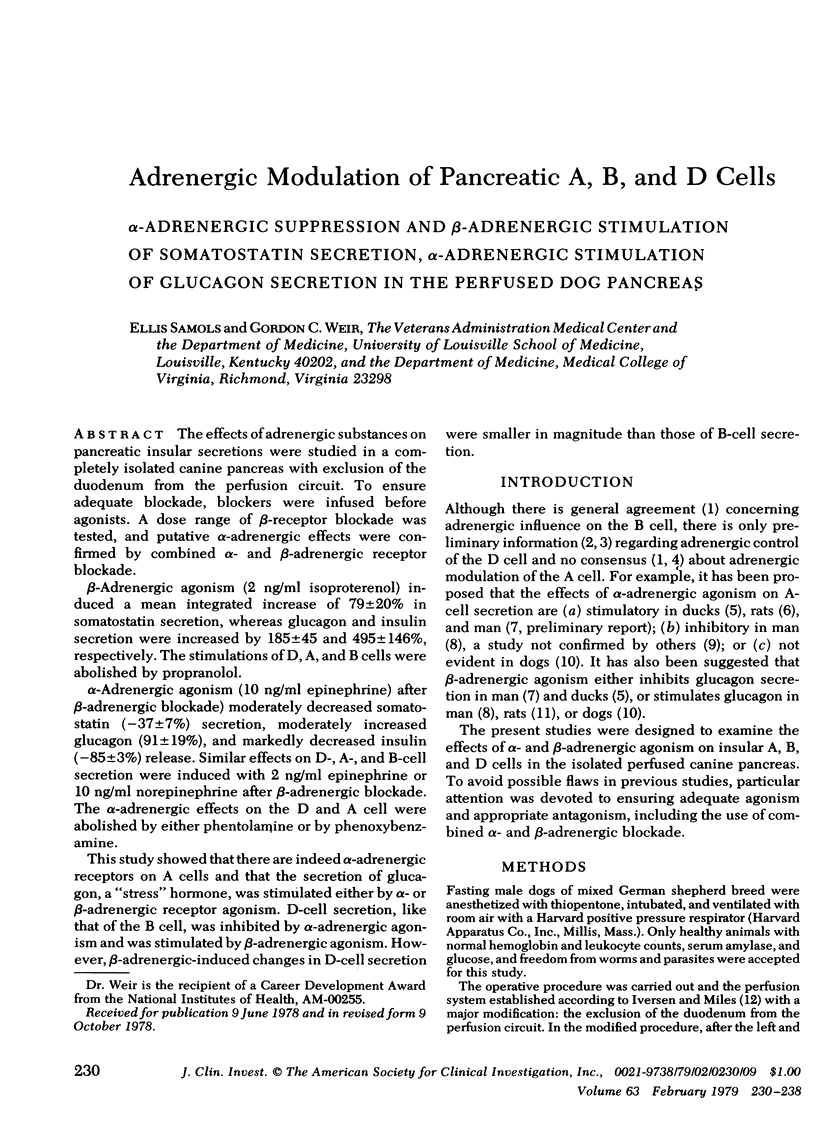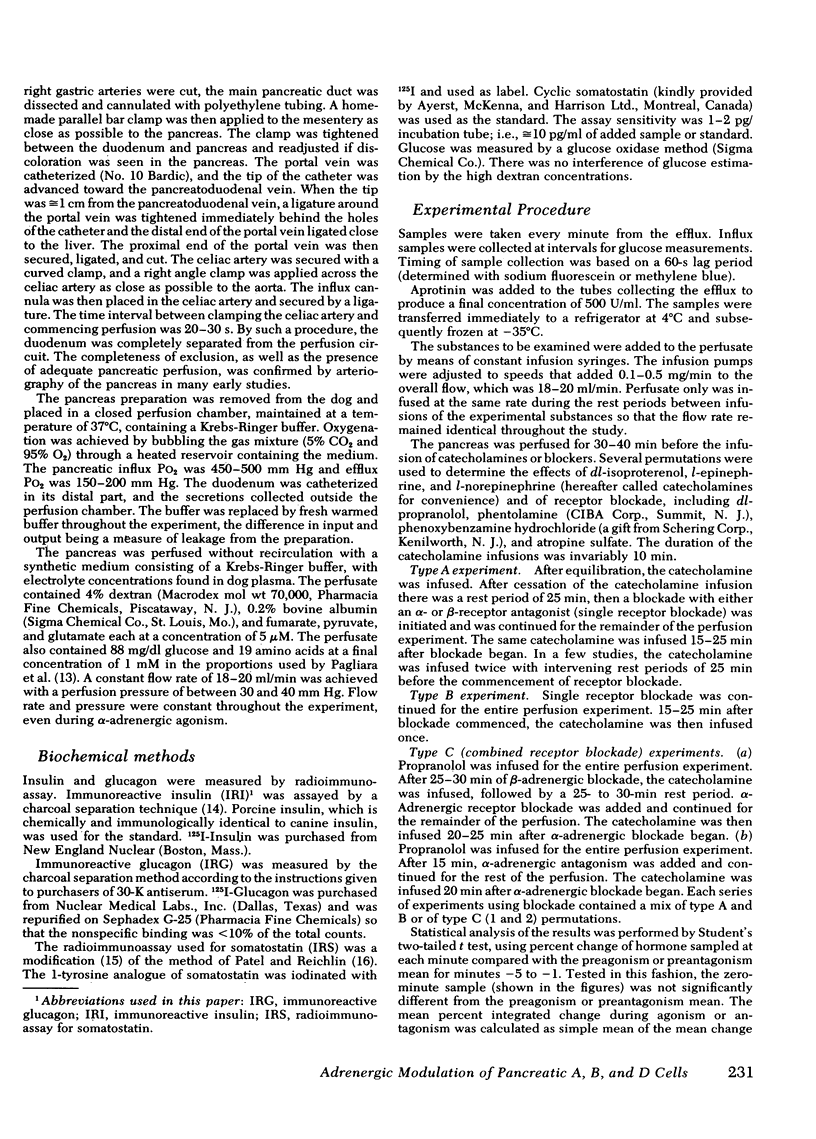Abstract
The effects of adrenergic substances on pancreatic insular secretions were studied in a completely isolated canine pancreas with exclusion of the duodenum from the perfusion circuit. To ensure adequate blockade, blockers were infused before agonists. A dose range of β-receptor blockade was tested, and putative α-adrenergic effects were confirmed by combined α- and β-adrenergic receptor blockade.
β-Adrenergic agonism (2 ng/ml isoproterenol) induced a mean integrated increase of 79±20% in somatostatin secretion, whereas glucagon and insulin secretion were increased by 185±45 and 495±146%, respectively. The stimulations of D, A, and B cells were abolished by propranolol.
α-Adrenergic agonism (10 ng/ml epinephrine) after β-adrenergic blockade) moderately decreased somatostatin (−37±7%) secretion, moderately increased glucagon (91±19%), and markedly decreased insulin (−85±3%) release. Similar effects on D-, A-, and B-cell secretion were induced with 2 ng/ml epinephrine or 10 ng/ml norepinephrine after β-adrenergic blockade. The α-adrenergic effects on the D and A cell were abolished by either phentolamine or by phenoxybenzamine.
This study showed that there are indeed α-adrenergic receptors on A cells and that the secretion of glucagon, a “stress” hormone, was stimulated either by α- or β-adrenergic receptor agonism. D-cell secretion, like that of the B cell, was inhibited by α-adrenergic agonism and was stimulated by β-adrenergic agonism. However, β-adrenergic-induced changes in D-cell secretion were smaller in magnitude than those of B-cell secretion.
Full text
PDF








Selected References
These references are in PubMed. This may not be the complete list of references from this article.
- Furchgott R. F. Pharmacological characteristics of adrenergic receptors. Fed Proc. 1970 Jul-Aug;29(4):1352–1361. [PubMed] [Google Scholar]
- Furchgott R. F. The pharmacological differentiation of adrenergic receptors. Ann N Y Acad Sci. 1967 Feb 10;139(3):553–570. doi: 10.1111/j.1749-6632.1967.tb41229.x. [DOI] [PubMed] [Google Scholar]
- Gerich J. E., Charles M. A., Grodsky G. M. Regulation of pancreatic insulin and glucagon secretion. Annu Rev Physiol. 1976;38:353–388. doi: 10.1146/annurev.ph.38.030176.002033. [DOI] [PubMed] [Google Scholar]
- Gerich J. E., Langlois M., Noacco C., Schneider V., Forsham P. H. Adrenergic modulation of pancreatic glucagon secretion in man. J Clin Invest. 1974 May;53(5):1441–1446. doi: 10.1172/JCI107692. [DOI] [PMC free article] [PubMed] [Google Scholar]
- Herbert V., Lau K. S., Gottlieb C. W., Bleicher S. J. Coated charcoal immunoassay of insulin. J Clin Endocrinol Metab. 1965 Oct;25(10):1375–1384. doi: 10.1210/jcem-25-10-1375. [DOI] [PubMed] [Google Scholar]
- Iversen J. Adrenergic receptors and the secretion of glucagon and insulin from the isolated, perfused canine pancreas. J Clin Invest. 1973 Sep;52(9):2102–2116. doi: 10.1172/JCI107395. [DOI] [PMC free article] [PubMed] [Google Scholar]
- Iversen J., Miles D. W. Evidence for a feedback inhibition of insulin on insulin secretion in the isolated, perfused canine pancreas. Diabetes. 1971 Jan;20(1):1–9. doi: 10.2337/diab.20.1.1. [DOI] [PubMed] [Google Scholar]
- Langer S. Z., Trendelenburg U. The effect of a saturable uptake mechanism on the slopes of dose-response curves for sympathomimetic amines and on the shifts of dose-response curves produced by a competitive antagonist. J Pharmacol Exp Ther. 1969 May;167(1):117–142. [PubMed] [Google Scholar]
- Pagliara A. S., Stillings S. N., Hover B., Martin D. M., Matschinsky F. M. Glucose modulation of amino acid-induced glucagon and insulin release in the isolated perfused rat pancreas. J Clin Invest. 1974 Oct;54(4):819–832. doi: 10.1172/JCI107822. [DOI] [PMC free article] [PubMed] [Google Scholar]
- Patel Y. C., Reichlin S. Somatostatin in hypothalamus, extrahypothalamic brain, and peripheral tissues of the rat. Endocrinology. 1978 Feb;102(2):523–530. doi: 10.1210/endo-102-2-523. [DOI] [PubMed] [Google Scholar]
- Polak J. M., Pearse A. G., Grimelius L., Bloom S. R. Growth-hormone release-inhibiting hormone in gastrointestinal and pancreatic D cells. Lancet. 1975 May 31;1(7918):1220–1222. doi: 10.1016/s0140-6736(75)92198-4. [DOI] [PubMed] [Google Scholar]
- Potter L. T. Uptake of propranolol by isolated guinea-pig atria. J Pharmacol Exp Ther. 1967 Jan;155(1):91–100. [PubMed] [Google Scholar]
- Samols E., Weir G. C., Ramseur R., Day J. A., Patel Y. C. Modulation of pancreatic somatostatin by adrenergic and cholinergic agonism and by hyper- and hypoglycemic sulfonamides. Metabolism. 1978 Sep;27(9 Suppl 1):1219–1221. doi: 10.1016/0026-0495(78)90046-x. [DOI] [PubMed] [Google Scholar]
- Walter R. M., Dudl R. J., Palmer J. P., Ensinck J. W. The effect of adrenergic blockade on the glucagon responses to starvation and hypoglycemia in man. J Clin Invest. 1974 Nov;54(5):1214–1220. doi: 10.1172/JCI107864. [DOI] [PMC free article] [PubMed] [Google Scholar]
- Weir G. C., Goltsos P. C., Steinberg E. P., Patel Y. C. High concentration of somatostatin immunoreactivity in chicken pancreas. Diabetologia. 1976 May;12(2):129–132. doi: 10.1007/BF00428977. [DOI] [PubMed] [Google Scholar]
- Williams L. T., Mullikin D., Lefkowitz R. J. Identification of alpha-adrenergic receptors in uterine smooth muscle membranes by [3H]dihydroergocryptine binding. J Biol Chem. 1976 Nov 25;251(22):6915–6923. [PubMed] [Google Scholar]
- Woods S. C., Porte D., Jr Neural control of the endocrine pancreas. Physiol Rev. 1974 Jul;54(3):596–619. doi: 10.1152/physrev.1974.54.3.596. [DOI] [PubMed] [Google Scholar]


